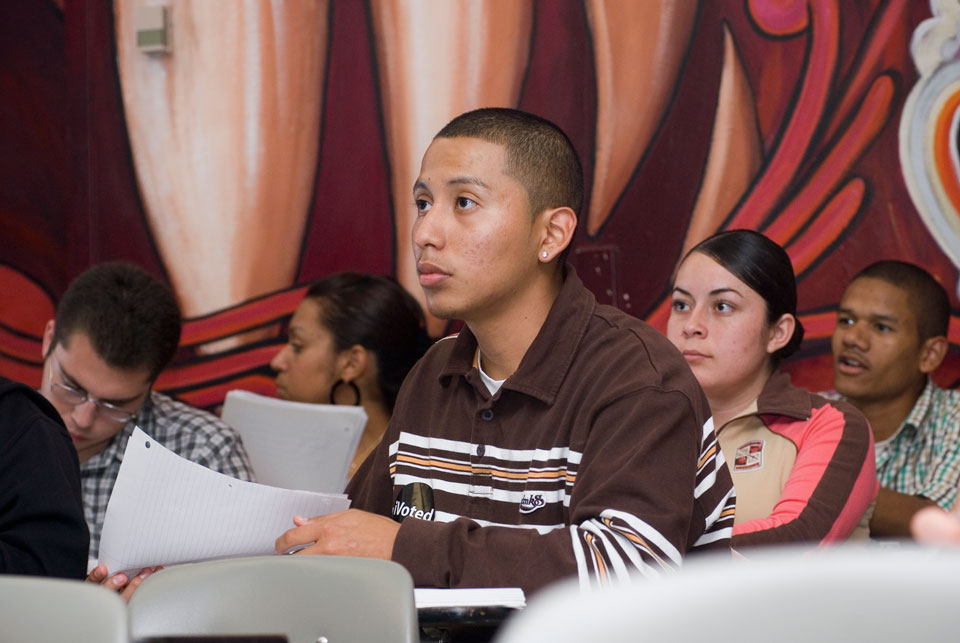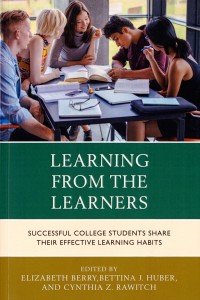CSUN Educators Listened to Students for Book on How to Be Effective Teachers

A team of CSUN researchers talked to more than 700 students to find out what makes an effective teacher. The results of their study can be found in the new book “Learning from the Learners.” Photo by Lee Choo.
Educators and policy makers have argued for years about the most effective ways to foster student learning, but rarely have they asked students to tell them what helps them learn.
A team of researchers at California State University, Northridge did just that. Over the course of 10 years, they talked to more than 700 high-performing undergraduate students and asked them what helped them in college. The results of the study can be found in the new book, “Learning from the Learners: Successful College Students Share Their Effective Learning Habits,” which offers insights into how educators can become better at teaching, and students become better at learning.
“Students know what makes a good or bad teacher,” said CSUN geography professor Steven Graves, who took part in the study and contributed a chapter to the book. “With this study, we listened to the students to learn how we can be better teachers.”
Journalism professor Linda Bowen, who also took part in the project and co-wrote another chapter of the book, said that in the process of listening to the students, “we learned that a lot more of them are ready for college and able to handle things than we think, if we get the teaching right.”
 For 10 years, faculty and staff from disciplines across the campus examined the learning habits of successful students based on what the students told them about their learning strategies, their plans for succeeding in college, and the learning approaches they thought best fostered a positive learning environment. The Learning Habits Project included both open-ended survey responses and in-depth interviews with more than 700 CSUN students, following them annually from their freshman year to graduation.
For 10 years, faculty and staff from disciplines across the campus examined the learning habits of successful students based on what the students told them about their learning strategies, their plans for succeeding in college, and the learning approaches they thought best fostered a positive learning environment. The Learning Habits Project included both open-ended survey responses and in-depth interviews with more than 700 CSUN students, following them annually from their freshman year to graduation.
“With one or two exceptions, no other volume on the widely discussed hot topic of student success relies on such a wealth of data about what works from the point of view of students,” said Bettina Huber, former director of CSUN’s Office of Institutional Research, who led the study with communications studies professor emerita Elizabeth Berry.
The study’s results offered some surprises and affirmed what many participants suspected, but did not have the data to back their suspicions.
Many of the positive things that faculty did in class appeared to be basic, but were transformative for the students, such as a professor learning the names of the students.
“You wouldn’t think that would be important, but it is,” Graves said. “It tells the students that they matter to the professor. That sort of connection can be difficult to build in large classes — I’ve got one class with 125 students in it. Sometimes you don’t have an opportunity to know them individually, so you might take the opportunity to let them get to know you a little better, to make that connection that you trust them enough to share a bit of yourself with them. In return, they trust you.”
The researchers found insisting that students take advantage of faculty office hours or encouraging study groups helps students tap into support networks when they need help. And passion for the subject being taught can turn that teacher and class into a favorite.
Cynthia Rawitch, former vice provost and one of the volume’s editors, recalled interviewing a biology major who credited her excitement for a class on DNA to the professor, who clearly loved the subject.
“Students are very astute at picking up body language,” Rawitch said. “When a teacher is passionate about a subject, the students, for the most part, will be too.”
One of the things the researchers found that they needed to improve was the students’ ability to read effectively at the college level.
“We spend so much time making sure students are college ready when it comes to math and writing, we’ve forgotten about reading,” said Bowen, who co-wrote the chapter “Reading with Understanding.”
She noted one student who, when asked about his reading strategies, responded: “I haven’t really taken any classes that have been particularly helpful in developing my reading skills. Any development in my reading has come from my own analyzations of what I need to gain from reading. Over time, I’ve learned by trial and error.”
Bowen said educators could save students a lot of “trial and error” if they shared their own strategies for succeeding in college.
“When you talk to the students and they tell you the strategies they have come up with to succeed, it seems pretty basic and logical,” Bowen said. “But they had to create these strategies for themselves. It’s pretty simple to take just a couple minutes at the beginning of class to share what helped us when we were students. They don’t have to follow the advice, but you’ve given them something to add to their tool box, in case they need it.”
Among the surprises for Rawitch was how much the students disliked the use of electronic technologies in the classroom if they were poorly used.
“We heard that over and over again,” she said. “PowerPoints are the obvious ones. It was like all the faculty in the university decided that PowerPoints were the way to go. Some learned how to do it, others did not. You have students in class after class after class looking at PowerPoints on walls, on boards and laptops, and the faculty were just as boring as they were before.
“One of the things I learned is that doing something badly is almost as bad, or maybe worse, than not doing it in the first place,” Rawitch said.
Graves, who wrote the chapter “Being the First to Go to College, said an assumption is often made that first-generation students are underprepared for college.
“While they may not have a tradition of going to college in their families, or they come from schools that have high achievement gaps, what many of their families do give them, for lack of a better word, is grit,” Graves said.
“Their freshman year may be difficult,” he said. “There may be a bit of a culture shock. But by the end of year four, they have caught up, and they are successful students. They may not have the experiences other students have, but the sacrifices they and their families have made to get them to college have given them a different set of tools, grit and determination, that they can draw on to succeed.”
Graves said some first-generation college students suffer from “imposter syndrome,” the belief that they don’t really belong in college.
“We, as instructors, have to disabuse them of that as best we can,” he said. “They are just going through a bit of adjustment, and we now have the data to prove it with this study.”
Even before the study was complete, Bowen said, faculty and administrators across the campus were using what they were learning to make the university more learning-centered and their teaching more engaging.
“The students know what makes good educators,” she said. “It’s important that we listen to them.”

 experience
experience